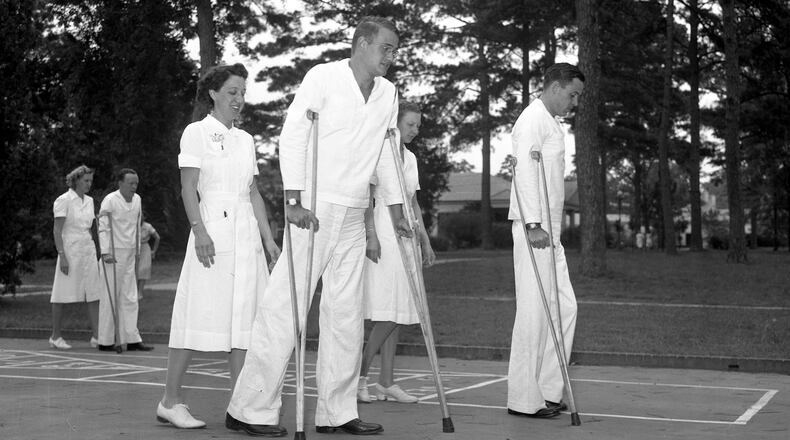Wayne Nichols, Buford:
I contracted polio in 1953 and was put into a contagion ward. My cousin also had polio and it attacked his lungs. He was put in an iron lung, and it was (a) death sentence and he lived for three years. I was fortunate. I had polio in my left leg, and had three surgeries as a kid to get me walking. I joined the Navy for two years and worked in construction. In my 50s, I experienced the first effects of post-polio. I had to have three back surgeries with pins and all. Then, as time went on, I lost 80% of the nerves from the knee down. I now walk with a cane. If it’s long distance, I use a wheelchair. It has been quite a ride. If I think about all of the time of my life I spent in hospitals, in surgeries, in recovery — you don’t want your kids to go through what I did.
Credit: Pat Harris
Credit: Pat Harris
Pat Harris, Carrolton:
I lived in a poor, Black community in Winston Salem, North Carolina, and was one of two children who contracted polio as a result of getting the vaccine. I also had measles, tonsillitis and bronchitis at the same time. None of this diminished my goals. Many people encouraged me. I was successful despite of it all. I taught second through sixth grade for the last 25 years in the U.S. Virgin Islands, Missouri, Florida, North Carolina and Georgia. Post-polio is what happens later on in your life as a result of having had polio. Today I have weakness, fatigue, problems with breathing and problems with swallowing. I’m on a C-PAP machine and use a motorized chair. I recently started a nonprofit, the JoseWinn Center, which serves vegetarian meals, offers clothing, hygiene kits, books for children and anything else the community needs.
Credit: AJC File
Credit: AJC File
Bernetta Calhoun, Atlanta:
I’m originally from Detroit, and had polio when I was 3. There was an outbreak in the hospital and I got there. I had several surgeries growing up. Polio robed me of my muscular functions, and caused a lifetime of disability. In my 60s, I couldn’t climb stairs or lift my legs like I used to. At first it was subtle, and later I became aware that something drastic was taking place. I used to walk around on crutches. Now I am in a scooter, and there are limits to what I can do and where I can go. I’m now in my 70s and permanently in a wheelchair. I was a single parent and got my daughter through high school and college — I worked to support both of us. I consider that one of my biggest achievements. From Detroit, I moved to California and worked as a programmer analyst at Motown. Got to meet and interact with the artists — I was able to meet Berry Gordy, Diana Ross, Stevie Wonder, the Jackson Five. As part of the job, we had to attend as many of the concerts as we could. That’s how I met Tina Turner. It was a very rewarding job. Being a single parent in California was expensive, it was hard to buy property, and then there was a major earthquake. My relatives in California migrated to Atlanta and when I visited, I fell in love with Atlanta and its trees, the sense of community.
John Brooks, Atlanta:
My mother died in 2017 from post-polio, which she had as a child. I spent my career caring for and treating people who have HIV. I hope one day that we can look back at HIV and say ‘wow, that’s something we don’t have anymore’ like we do with polio. That should be our goal. Dr. Brooks retired in September 2024 as CDC epidemiologist and chief medical officer for the CDC’s HIV prevention program.
Credit: Joe Drogan
Credit: Joe Drogan
Joe Drogan, Dawsonville:
Just about the time I had matured enough to accept my polio handicap, my big surprise was: it gets worse. Many polio survivors develop what’s called post-polio syndrome. It occurs about 40 years after the initial polio infection. It usually coincides with the severity of the initial polio infection, but not always. It causes new muscle weakness in the non-polio muscles, mental fog and fatigue. It often varies from day to day, there is no cure only preventative measures. These include not overusing our muscles. The opposite of “no pain, no gain.” The bad news is most of us are Type-A personalities. (Don’t tell me what I can’t do, just get out of the way!) The good news is most of us have learned to cope with adversity in life and adjust well.
Rita D. Carlson, Lawrenceville:
I was diagnosed at 12 years old and it left me with a limp – so I consider myself lucky, many of my friends who had polio are in wheelchairs. If we don’t administer vaccines for polio, the virus will come back. It’s that simple.
Famous Polio Sufferers
President Franklin D. Roosevelt; actors Mia Farrow, Alan Alda and Donald Sutherland; musicians Itzhak Perlman, Neil Young and Joni Mitchell; photographer Dorothea Lange.
Credit: AP
Credit: AP
About the Author
Keep Reading
The Latest
Featured







